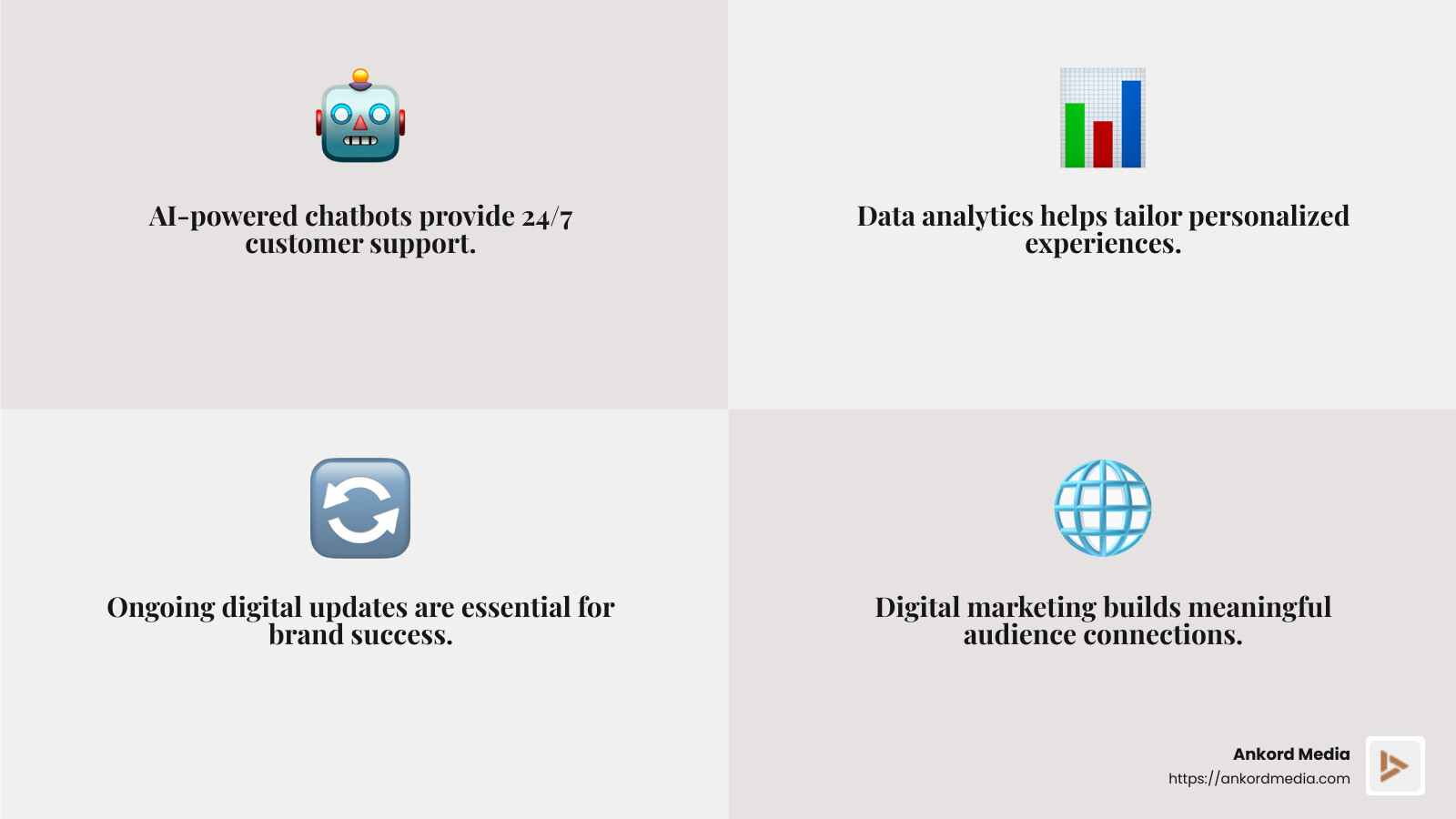Digital Brand Transformation: The Future is Now

Digital brand change is more than just a buzzword; it's a necessity in today’s digital age. At its core, it involves a complete overhaul of how a brand interacts with its audience, leveraging technology to improve customer experiences and streamline operations. Now, what does successful digital brand change look like?
- Accept new technologies to improve brand communication.
- Streamline operations for efficiency.
- Personalize customer interactions through digital tools.
- Adapt to evolving consumer behaviors and expectations.
Businesses must rethink how they weave technology into their brand strategies to remain relevant and competitive. It's not just about maintaining an online presence; it's about creating meaningful and engaging online experiences that resonate with consumers. As Rodney Zemmel from McKinsey mentions, the digital landscape is accelerating across all industries, making digital change an essential business practice.
I’m Milan Kordestani, CEO and founder of Ankord Media. My expertise lies in leading brands through their digital brand change journeys, ensuring they connect deeply with their audiences. Growing up in Silicon Valley, I have a unique perspective on how successful brands are built in the digital age.

Understanding Digital Brand Change
Digital brand change is a fundamental shift in how businesses interact with their customers. It's not just about having a website or a social media account. It’s about rewiring the way a brand operates to create seamless and engaging customer experiences.
Rewiring for Success
At the heart of digital brand change is the idea of rewiring. This involves integrating digital tools and platforms into every aspect of your brand's operations. This isn't a one-time project; it's an ongoing evolution.
Think of it as upgrading the operating system of your brand. Just like a computer needs regular updates to run smoothly, brands need to continuously accept new technologies to stay ahead. Experts highlight that digital changes are long-term efforts to rewire how an organization continuously improves and changes.
Enhancing Customer Experience
Customer experience is at the core of digital brand change. In today's digital world, customers expect personalized and seamless interactions with brands.
Imagine walking into a store and having the staff know exactly what you like and need. Digital tools can make this possible online. For example, AI-powered chatbots can provide instant customer support, while data analytics can help brands understand consumer preferences and tailor experiences accordingly.

The Role of Digital Marketing
Digital marketing plays a vital role in digital brand change. It’s not just about promoting products but about creating meaningful connections with your audience.
Brands must leverage digital marketing strategies to engage with customers across multiple channels. This includes social media, email marketing, and even mobile apps. By doing so, brands can ensure they reach their audience where they spend most of their time.
Digital brand change is about creating a cohesive and integrated approach to brand management. It's about using technology to improve every customer touchpoint and deliver a consistent brand message.
As we dive deeper into the components of digital brand change, we'll explore the platforms and ecosystems that are essential for creating these transformative experiences.
Key Components of Digital Brand Change
Digital brand change isn't just about adopting new tools; it's about building a robust foundation that supports change across platforms, ecosystems, and customer touchpoints. Let's explore these components in detail.
Platforms: The Backbone of Change
Platforms are the digital spaces where brands interact with their customers. Think of them as the virtual storefronts of the digital age. They include websites, mobile apps, and social media channels. For a successful digital brand change, it's crucial to ensure these platforms are user-friendly, responsive, and aligned with your brand identity.
Websites should be more than just informative. They must provide a seamless user experience, with intuitive navigation and engaging content. Mobile apps should offer value-added services that improve customer experience, like personalized recommendations or exclusive promotions.
Social media is another critical platform. It's where much of the consumer conversation happens. Brands that engage effectively on social media can build strong relationships with their audience, turning followers into brand advocates.
Ecosystems: Creating Synergy
An ecosystem in the context of digital brand change refers to the interconnected network of platforms, technologies, and partnerships that a brand uses. It's about creating synergy between different elements to offer a unified experience.
For instance, integrating e-commerce platforms with social media and customer relationship management (CRM) tools can create a seamless shopping experience. This interconnectedness allows brands to gather valuable insights into customer behavior and preferences, enabling more personalized interactions.
Buzzfeed is a great example of leveraging an ecosystem. By pairing editors with data scientists, they use data-driven insights to tailor content that resonates with their audience, boosting engagement and growth.
Customer Touchpoints: Every Interaction Matters
Customer touchpoints are the various interactions a consumer has with a brand. Each touchpoint is an opportunity to strengthen brand equity and nurture customer relationships. In a digital brand change, optimize these touchpoints to ensure a consistent and positive brand experience.
From the moment a customer visits your website to when they receive a follow-up email, each interaction should reflect your brand's values and promise. Leveraging technologies like AI and data analytics can help personalize these interactions, making customers feel valued and understood.
Consider the use of secure QR codes to provide seamless access to content or promotions. They bridge the gap between offline and online experiences, enriching the customer's journey and enhancing brand engagement.
By focusing on platforms, ecosystems, and customer touchpoints, brands can create a cohesive digital experience that not only meets but exceeds customer expectations. Understanding the strategic implementation of these components will be crucial for brands aiming to succeed in the digital age.
How to Implement Digital Brand Change
Implementing digital brand change requires a strategic approach that aligns with your business goals. Let's break it down into three vital components: strategy, talent, and operating model.
Strategy: The Roadmap to Success
A clear strategy is the backbone of any successful digital brand change. Start by identifying the specific areas where digital change can add the most value. Is it in enhancing customer journeys, streamlining processes, or upgrading specific functions?
Create a detailed roadmap that outlines the solutions and resources needed for these prioritized areas. This roadmap should align with your overall business objectives and be flexible enough to adapt to evolving market dynamics.
Tip: For every dollar spent on developing digital solutions, plan to spend at least another dollar on implementing process changes, user training, and change-management initiatives. This ensures that digital changes are fully acceptd and deliver maximum value.
Talent: Building a Strong Team
Digital change is as much about people as it is about technology. You need a strong bench of in-house digital talent working alongside business colleagues. This means going beyond hiring. Develop employee value propositions that attract and retain top talent.
Invest in agile and digital HR processes to find, manage, and train talent. Create an environment where the best talent thrives. No company can outsource its way to digital excellence.
Case Study: Amazon invested in technology, data, and talent over the years to become an industry leader. Their success highlights the importance of nurturing in-house talent capable of driving digital change.
Operating Model: Scaling for Success
An effective operating model is crucial for scaling digital brand change. This involves forming cross-functional teams that bring together people from across the company. Consider different operating models like the digital factory, product and platform model, or enterprise-wide agility model.
These models help scale the change to support hundreds or thousands of teams, ensuring that digital change is not just a one-off project but a sustainable shift in how the organization operates.
Fact: High-performing teams can be five times more productive than low-performing ones. Fostering such teams is essential for driving successful digital brand change.
By focusing on strategy, talent, and operating model, brands can implement a robust digital brand change. These components work in harmony to ensure that digital changes are not only implemented but also sustained, leading to long-term success in the digital age.

The Role of AI in Digital Brand Change
Artificial Intelligence (AI) is changing the way brands operate and engage with their audiences. It's not just about adopting new technology; it's about aligning AI with your business goals to drive meaningful change.
AI Change: A New Era for Brands
AI is reshaping how brands interact with customers. It's about creating smarter, more personalized experiences. For instance, AI can analyze customer data to predict preferences and tailor marketing messages accordingly. This level of personalization was unimaginable a few years ago.
Tip: Always start with the business problem you want to solve. AI should be a tool to achieve your goals, not a shiny object to chase. As McKinsey notes, “The conversations around generative AI make it feel like a technology in search of a problem.” Focus on the problems first, then find the AI solutions that fit.
Generative AI: Beyond the Buzz
Generative AI, like the technology behind tools such as ChatGPT, is changing the game. It's not just about automating tasks; it's about creating new content and experiences that resonate with users. Imagine AI generating personalized product recommendations or crafting engaging social media posts.
Case Study: Buzzfeed pairs editors with data scientists to make data-driven editorial decisions. This combination of traditional roles with AI insights leads to engaging content and business growth.
Aligning AI with Business Goals
For AI to truly transform your brand, it must align with your business objectives. This means integrating AI into your digital brand change strategy. Consider how AI can improve customer journeys, streamline operations, or create new business models.
Fact: Companies that align AI with their business goals see greater success in digital change. It's about being strategic and ensuring AI initiatives are scalable and add real value.
By leveraging AI in your digital brand change, you can open up new opportunities for growth and innovation. The key is to use AI thoughtfully, focusing on how it can help achieve your business goals.
Next, we'll dive into some frequently asked questions about digital brand change to further guide your change journey.
Frequently Asked Questions about Digital Brand Change
What are the 4 P's of digital change?
Digital change can be broken down into four key components, often referred to as the "4 P's": Platform, People, Project, and Process.
- Platform: This refers to the digital tools and technologies you use. A strong platform is essential for seamless operations and customer interactions. Think of it as the foundation for your digital brand change.
- People: Your team is crucial. They need the right skills and mindset to drive digital change. Investing in training and development ensures your people are ready to accept new technologies and methods.
- Project: Every digital change initiative should be treated as a project with clear goals, timelines, and KPIs. This helps in keeping the change on track and measuring success.
- Process: Efficient processes are the backbone of digital change. Streamlining operations and adopting agile methodologies can make your brand more responsive and adaptable.
What are the four types of digital change?
Digital change can manifest in various ways, categorized into four types: Business Process, Business Model, Domain, and Cultural.
- Business Process: This involves optimizing internal processes using digital tools. For example, automating repetitive tasks can free up time for more strategic activities.
- Business Model: Sometimes, digital change requires a shift in how you deliver value to customers. This might mean adopting a subscription model or creating digital-first products.
- Domain: Expanding into new digital markets or domains can open up new revenue streams. This could involve launching an e-commerce site or developing a mobile app.
- Cultural: Change isn't just about technology; it's also about people. Fostering a culture that accepts innovation and continuous learning is crucial for long-term success.
What are the 5 A's of digital change?
To steer digital change effectively, consider the "5 A's": Audience, Ads + Assets, Access, Attribution, and Automation.
- Audience: Understanding your audience is key. Use data to gain insights into their preferences and tailor your offerings accordingly.
- Ads + Assets: Your digital assets, including ads, should be consistent and aligned with your brand values. This helps in creating a cohesive brand identity across all platforms.
- Access: Ensure your digital platforms are accessible to all users. This includes mobile optimization and ensuring your website is easy to steer.
- Attribution: Understanding where your conversions are coming from is vital. Use analytics to track the effectiveness of your digital campaigns and adjust strategies as needed.
- Automation: Accept automation to improve efficiency and reduce manual workloads. This can include everything from email marketing automation to using AI for customer service.
These frameworks and concepts provide a roadmap for navigating the complex landscape of digital brand change. By understanding and applying these principles, you can position your brand for success in the digital age.
Conclusion
In the changing digital landscape, digital brand change is not just a trend—it's a necessity. At Ankord Media, we believe in partnering with visionary clients to turn bold ideas into reality. Our focus is on crafting authentic connections that resonate with audiences and drive meaningful engagement.
Visionary Branding: Our approach to branding goes beyond aesthetics. We work closely with our clients to develop strategies that align with their core values and business goals. This ensures that every digital touchpoint reflects the essence of the brand, creating a cohesive and memorable experience for customers.
Authentic Connections: Genuine connections are more important than ever. We leverage a unique blend of design, technology, and storytelling to create impactful digital experiences. Whether it's through a thoughtfully designed website or a compelling brand narrative, we aim to connect with audiences on a deeper level.
By embracing digital brand change, brands can stay ahead of the competition and thrive in the digital age. If you're ready to start on this transformative journey, let's work together to make your vision a reality.
Explore our services and find how we can help you achieve your digital brand change goals.

